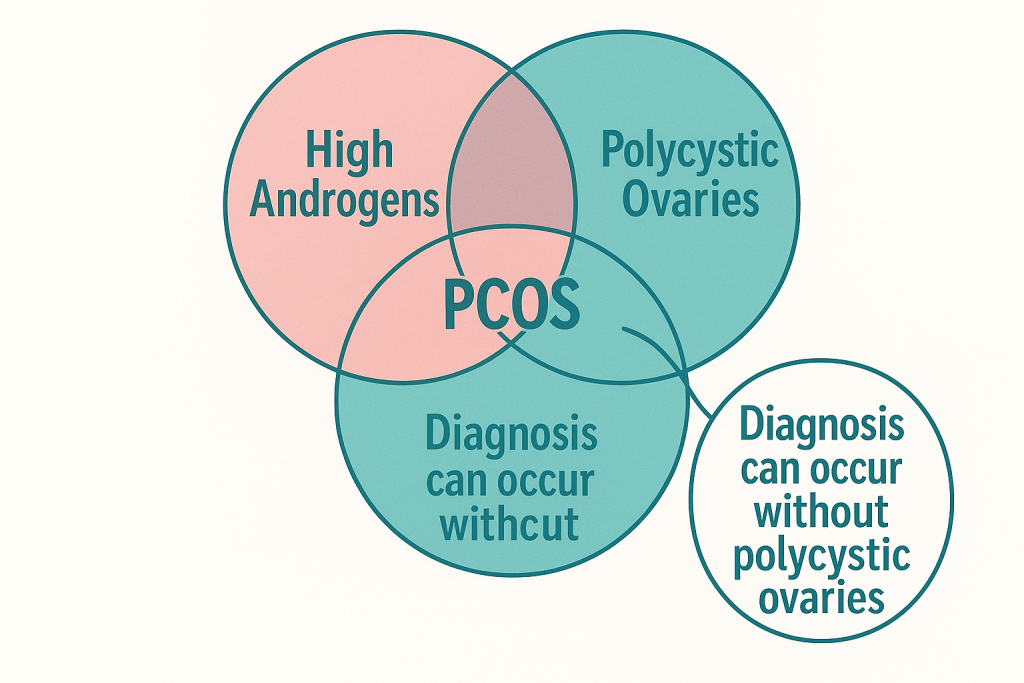
PCOS—or Polycystic Ovary Syndrome—often causes confusion, not only because of its name but also due to persistent myths about what it means to have this condition. One of the most common misconceptions is that you must have ovarian cysts to be diagnosed with PCOS. Let’s debunk this with research-backed facts and international guidelines.
The Myth
“You must have ovarian cysts to have PCOS.”
This myth stems from the term “polycystic,” which literally means “many cysts.” It’s easy to believe that cysts are a mandatory part of the condition, but the truth is very different.
The Facts: What Do International Guidelines Say?
What Is PCOS, Really?
PCOS is a hormonal disorder that affects 8–13% of women of reproductive age worldwide. The symptoms are complex and varied, including irregular periods, signs of excess androgens (such as hirsutism or acne), and sometimes, polycystic-appearing ovaries on ultrasound. But here’s the key: not everyone with PCOS has ovarian cysts, and not everyone with ovarian cysts has PCOS.
The Rotterdam Criteria
International guidelines (including the 2023 International Evidence-Based Guideline for the Assessment and Management of PCOS and the widely accepted Rotterdam Criteria) agree that you only need two out of three of the following features to be diagnosed with PCOS:
Irregular or infrequent ovulation (manifested as irregular cycles)
Clinical or biochemical signs of excess androgens (e.g., acne, hirsutism, elevated testosterone)
Polycystic ovarian morphology seen on ultrasound (multiple small follicles on an ovary)
You Can Have PCOS Without Cysts
You do not need to have cysts to be diagnosed with PCOS. If you have irregular periods and signs of excess androgens, you meet the criteria—even if your ovaries are not “polycystic” on ultrasound. In fact, many adults on hormonal birth control pills or with certain medical backgrounds may not show these typical ultrasound findings, but still meet the diagnosis based on other symptoms.
Polycystic Ovaries ≠ Ovarian Cysts
The so-called “cysts” seen in PCOS are actually small, undeveloped follicles—not typical ovarian cysts. Functional ovarian cysts (single, larger fluid-filled sacs) are common and unrelated to PCOS. The ultrasound appearance of “polycystic ovaries” is simply one possible component of the syndrome.
I remember my very first ultrasound scan, and I remember how the undeveloped follicles reminded me of tablet blisters that could be popped, around the ovaries. I assumed that this confirmed that I had cysts and was sad and depressed. Imagine my confusion when the “cysts” cleared and the doctor insisted I still had PCOS. It was a relief to discover that international guidelines focus on the bigger picture, not just one organ or scan.
You are more than just an ovary!
Key Takeaway
Having ovarian cysts is not a requirement for a PCOS diagnosis. International guidelines and current science emphasize that PCOS is defined by a combination of symptoms, not just ultrasound findings. You can have PCOS without ever having a visible cyst.
Next up
References
World Health Organization: WHO & World Health Organization: WHO. (2025, February 7). Polycystic ovary syndrome. Retrieved from Polycystic ovary syndrome fact sheet.
Polycystic ovary Syndrome (PCOS). (2025, June 2). Retrieved from Cleveland Clinic
Christ, J. P., & Cedars, M. I. (2023). Current guidelines for diagnosing PCOS. Diagnostics, 13(6), 1113. Current Guidelines for Diagnosing PCOS – Following Rotterdam Criteria
Website, N. (2025, July 9). Diagnosis. Retrieved from https://www.nhs.uk/conditions/polycystic-ovary-syndrome-pcos/diagnosis/
International Evidence-based Guideline for the assessment and management of polycystic ovary syndrome | RCOG. (n.d.) 2023. Retrieved from https://www.rcog.org.uk/guidance/browse-all-guidance/other-guidelines-and-reports/international-evidence-based-guideline-on-polycystic-ovary-syndrome/
